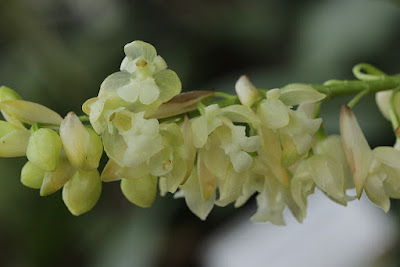Pholidota ventricosa is native to New Guinea, Borneo, Sumatra, Java and Malaysia. Although it occurs in a relatively large area, it usually grows at heights of 1585 m, in addition to the northernmost parts of habitats...
Pholidota ventricosa also called as The Thick Bellied Pholidota, Chelonanthera ventricosa, Coelogyne ventricosa, Pholidota grandis, Pholidota sesquitorta, Pholidota sororia, is a species of the genus Pholidota. This species was described by Heinrich Gustav Reichenbach in 1857.
IDENTIFY PHOLIDOTA VENTRICOSA
Pholidota ventricosa is native to New Guinea, Borneo, Sumatra, Java and Malaysia. Although it occurs in a relatively large area, it usually grows at heights of 1585 m, in addition to the northernmost parts of habitats.
It is a large sized, warm to cold growing epiphyte, which reaching 46-81 cm in height, with close set, elliptic, 5-15 cm long pseudobulbs carrying 2, apical, narrowly lanceolate, acute, plicate, 5 nerved, elongate petiolate base, 46-61 cm long leaves.
The Thick Bellied Pholidota blooms in the fall on a stiffly erect, to 50 cm long, slightly compressed, many flowered inflorescence arising on an immature pseudobulb. The flowers are 1 cm in diameter, broadly spread, greenish petals of the outer whorl and almost white, sharply curving petals of the inner whorl. The lip is prominent, cloudy white or creamy in addition to the depth of the throat, where it has a yellow color. The aroma is described as sweetish, and the flower casing falls.
PHOLIDOTA VENTRICOSA CARE AND CULTURE
Cultural information should only be used as a guide, and should be to be adapted to suit you. Your physical location; where you grow your plants, how much time you have to devote to their care, and many other factors, will need to be taken into account. Only then can you decide on the cultural methods that best suit you and your plants.
Light:
Pholidota ventricosa needs a light level of 15000-24000 lux. The light should be dispersed or filtered and direct sunlight should be avoided.
Temperature:
The average temperature of the day is 23-25 ° C, night 13-15 ° C, with a daily difference of 9-11 ° C. During the year, average temperatures change little, and extreme temperatures are close to average temperatures, which indicates that plants can not tolerate temperature fluctuations.
Humidity:
The Thick Bellied Pholidota needs the humidity of 75-80% throughout the year.
Substrate, growing media and repotting:
Pholidota ventricosa can be installed on tree fern or cork which supports favors their creeping cut. They can also be planted in pots filled with bark or a mixture of tree fern fibers. Repotting should be carried out as rarely as possible and only when new roots are actively growing.
Watering:
The plants should be kept constantly moist. The precipitation scheme is wet / wet.
Fertilizer:
Weekly application of 1/4-1/2 of the recommended dose of orchid fertilizer during active growth is recommended.
Rest period:
The given cultivation temperatures should be maintained throughout the year. In winter, the amount of water and fertilization can be reduced, but the plants can not completely dry out.















COMMENTS